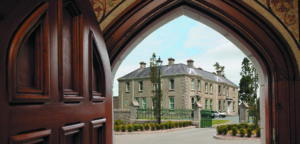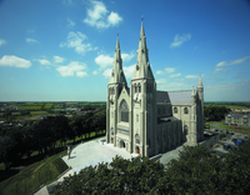Archbishop William Crolly (1835-1849) negotiated the current site for the Catholic Cathedral of St Patrick in Armagh from the Earl of Dartrey. The original architect was Thomas J. Duff of Newry. The work of construction lasted from St Patrick’s Day 1840, when the foundation stone was blessed and laid, with occasional intermissions until the year 1904 when the solemn ceremony of consecration took place. One of the longest gaps in construction took place during the years of the Great Famine. With the dreadful spectre of hunger and disease stalking the land, Cathedral funds were understandably diverted to the more pressing cause of famine relief. Indeed the cholera disease claimed the primate himself and in 1849 his body was laid to rest, at his own request, under the sanctuary of his unfinished Cathedral.
Primate Joseph Dixon (1852-1866) declared Easter Monday 1854, ‘Resumption Monday’. Financial contributions for the Cathedral came from across the Atlantic and to raise extra funds Dr Dixon took the step, rare in those days, of organising a great Bazaar. ‘The First Bazaar’ of 1865 became a household word in Armagh, not alone for its material success (over £7,000 was raised, a remarkable sum for the times), but also for the unique character of some of the prizes. Pope Pius IX sent a beautiful ivory carving of Raphael’s ‘Madonna Di Foligno’. The Emperor of Austria sent a table of rare inlaid work specially designed for the occasion, while Napoleon II chose from the Tuileries Staterooms two magnificent vases of Old Sevrés. An interesting relic of the Bazaar is the grandfather clock now standing in the Cathedral Sacristy. This was a prize which has never been claimed!!
When work resumed in 1854 the original architect Thomas Duff had died and the famous Irish neo-Gothic architect, J. J. McCarthy, was appointed to complete the work. He proposed a different design. The original plan had proposed a perpendicular Gothic church. However, since the original plan of Duff had been adopted for Armagh, an architectural renaissance had taken place and there was a growing tendency to favour a return to purer styles of which perpendicular Gothic was seen as a decadent modification. What McCarthy drew up was a continuation design in the old fourteenth century style of decorated Gothic.
Under Archbishop Daniel McGettigan (1870-87) the Cathedral was completed and dedicated on 24 August 1873 attended by an estimated 20,000 people. Prior to the great occasion Dr McGettigan had seen to the construction of the seven-terraced flight of steps leading from the Cathedral gates to the piazza in front of the west door. In the years following the ceremony he continued to make additions. He built the Archbishop’s house in 1876-77 and in 1884-86 the sacristan’s lodge just inside the Cathedral gates.
The adornment of the interior of the Cathedral was completed under Cardinal Michael Logue (1887-1924). At that time the southern transept was still being used as an impoverished sacristy and assembly room for diocesan purposes. Cardinal Logue corrected this undesirable state of affairs which greatly detracted from the symmetrical beauty of the building’s interior by having constructed to the north east of the Cathedral the Synod Hall which houses the present sacristy. At this time the interior of the Cathedral was dull and undecorated. Cardinal Logue issued a pastoral letter, On the National Cathedral, out of which grew the famous ‘National Cathedral Bazaar’ of 1900 which realised a record sum of £30,000. It can be said that everything in the inside of the Cathedral, except for the Stations of the Cross and some windows in the Lady Chapel, dates from Cardinal Logue’s time.
At his own expense he went abroad and visited the Cathedrals of Italy. He went to the workshops of Rome and Cararra in his search for precious marbles for the construction of the reredos and pulpit as well as the altars. In an exquisite example of artistic workmanship a magnificent Gothic altar was erected in purest statuary marble. On the front it carried in high relief Leonardo Da Vinci’s Last Supper by the distinguished Roman sculptor, Cesare Aureli, which in the rearrangement of the sanctuary following Vatican II, was transferred to St Patrick’s Church, Stonebridge, in the historic parish of Kilmore, where it still stands.
It was also the achievement of Cardinal Logue to have decorated with mosaic the entire walls from the floor to the groining. The materials used were pottery and glass of various colours in dice-shaped cubes. The ceilings are painted in oils, the artist being Oreste Amici. The stained-glass windows, almost all of which date from Cardinal Logue’s time, are mostly the work of the German firm, Meyer. The great window in the Lady Chapel, which was erected at a cost of £920 by Dr McGettigan, at his own expense, came from Dublin.
It was with fitting pride, with his work of decoration complete, that Cardinal Logue announced 24 July 1904 as the solemn day of consecration. And when Pope Pius X deputed Cardinal Vincent Vannutelli, a distinguished member of the Roman Curia, to represent him at the ceremony in Armagh, Ireland felt herself signally honoured in her ecclesiastical capital.
No restructuring of the Cathedral was contemplated until the Second Vatican Council’s decree on Sacred Liturgy in the 1960s called for the redesigning of sanctuaries. In the competition for the best design, first prize was awarded to architect, Liam McCormick of Derry. By raising, enlarging and opening the sanctuary area the architect, to a great extent, restored the Cathedral to its original form, as proposed by Duff. The new sanctuary area was finished in Wicklow granite and the same material is used in the altar, ambo and tabernacle stand. All these sanctuary furnishings are the work of sculptor Peter McTigue of Dundalk. The new tabernacle door is a product of Kilkenny Design Workshops and the richly coloured sanctuary carpets were manufactured in Killybegs. Thus, as far as possible, Irish workmanship and materials were used. A new crucifix, the Cross of Christ was affixed to the huge pillar to the right of the sanctuary. This was the work of Imogen Stuart and relies heavily on St John’s theology of the life-giving death of Jesus, the structure of the cross reminiscent of the shoots from a sprouting seed, a theme popular in medieval crucifix carvings. The new sanctuary was dedicated on Sunday, 13 June 1982.
Abstracted from St. Patricks Cathedral, Armagh. Tomas Ó Fiaich. The Irish Heritage Series: 58, Eason & Sons Ltd, Dublin, 1987
The 2003 restoration arose out of the necessity for major
structural repairs to the Cathedral. To
oversee the project, Archbishop Seán Brady appointed a Diocesan committee whose
members took the opportunity of reviewing the sanctuary area, of restoring and
enhancing the interior decoration and of upgrading existing facilities.
The restoration work was undertaken by the established firm
of McAleer & Teague of Dromore, Co. Tyrone, under the supervision of
Gregory Architects,
to redesign the sanctuary.
In line with tradition pertaining to Cathedrals and in
accordance with liturgical norms, the Tabernacle has been relocated to a new
Blessed Sacrament Chapel in the South Transept. By doing so, a private space for prayer and meditation has been created.
To the rear of the new altar is the Archbishop’s chair, or ‘Cathedra’, from which the name
‘Cathedral’ comes.
The Lady Chapel, under the Great East Window, has been
enhanced as a shrine area and is now known as the Marian Shrine. It is separated from the sanctuary by a new
brass screen reminiscent of the marble and brass screen installed by Cardinal
Logue.
The Baptistery with its rich imagery in mosaic and stained
glass has been restored and is again used for baptisms.
An Evangelarium has been created in the space to the right
of the entrance doors. Here the Gospel
of the day may be read in quiet contemplation. On the walls are two marble plaques commemorating the consecration of
the Cathedral, 20th July 1904.
The total cost of the 2003 restoration amounted to £6
million pounds. In excess of £1 million
was grant-aided by the Heritage Lottery Fund and £300,000 from the Environment
& Heritage Service. The balance of
the cost was generously covered by parishioners and friends throughout the diocese
and beyond.
Since the building of the Cathedral was commenced in 1840,
thirteen primates, including seven cardinals, have each contributed in his own
way to its history. Its commanding site
overlooking the City gives it an enduring presence, a reminder to each
generation of the sacrifices of those who have gone before. The now restored building is a further
realisation of Dr Crolly’s vision of a Great National Cathedral of St Patrick
and one worthy of the Primatial See of Armagh.


